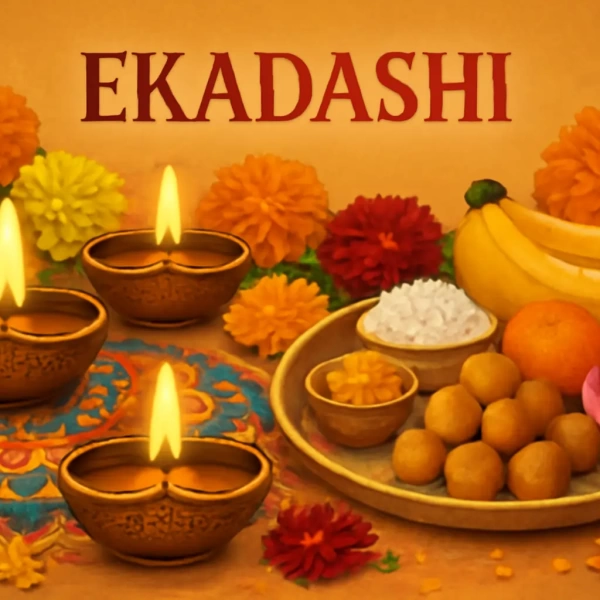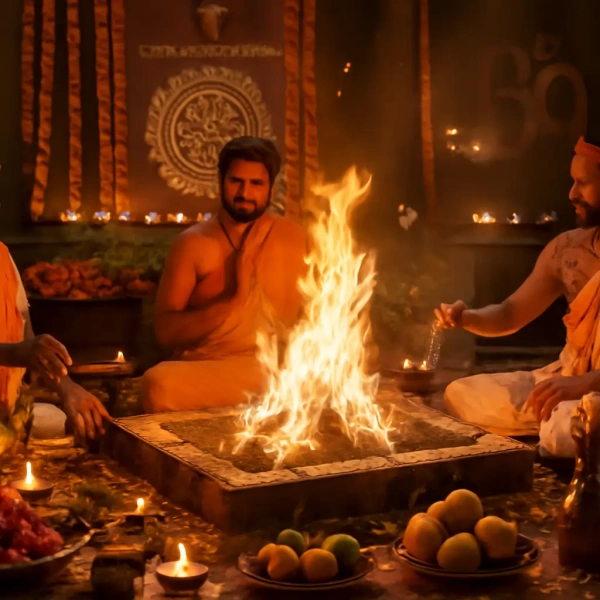
Chandi Homa is one of the most potent and transformative rituals in Hinduism, invoking the fierce and compassionate energy of Goddess Durga, also known as Chandi. Through the sacred recitation of Durga Saptashati and offerings into a consecrated fire, devotees seek protection, prosperity, and spiritual evolution. This comprehensive guide covers everything from the meaning and structure to the step-by-step procedure, materials needed, and spiritual significance of Chandi Homa.
What is Chandi Homa?
Chandi Homa is a powerful Vedic fire ritual dedicated to Goddess Durga. It combines:
- Durga Saptashati Recitation: 700 sacred Sanskrit verses praising the Divine Mother.
- Fire Offerings (Ahuti): Offerings like ghee, grains, and herbs are made into a sacred fire.
It is performed to invoke the divine feminine energy (Shakti) for spiritual upliftment, inner strength, and worldly success.
Meaning of Terms
- Chandi: “The fierce one” – an aspect of Durga
- Homa: Fire ritual with offerings to deities
- Durga Saptashati: 700 verses from the Markandeya Purana glorifying Durga
- Also Known As: Devi Mahatmya, Chandi Path, Durga Path
Durga Saptashati: The Sacred Text
Overview
Durga Saptashati is composed of 700 slokas divided into 13 chapters, recounting the battles of Goddess Durga against powerful demons.
Three Core Stories
- Madhu-Kaitabha (Chapter 1):
- Vishnu defeats demons with Mahamaya’s help
- Symbolizes victory over ego and ignorance
- Mahishasura (Chapters 2-4):
- Durga slays the buffalo demon
- Celebrated during Navratri
- Shumbha-Nishumbha (Chapters 5-13):
- Durga and her forms destroy demonic brothers
- Represents triumph of divine feminine over negative forces
Structure
- Verses: 700
- Chapters: 13
- Language: Sanskrit
- Recitation Time: 2–3 hours
Chandi Homa Ritual Process
Pre-Ritual Preparations
- Purification: Bath, clean clothes, meditation
- Setup:
- Homa Kund (fire pit)
- Sacred fire (from mango, banyan, or peepal wood)
- Offerings: ghee, grains, flowers, fruits
- Ritual items: Kalash, incense, camphor
Step-by-Step Procedure
- Sankalpa (Sacred Intention)
- Declaring name, purpose, date, location
- Invocation (Avahana)
- Calling Goddess Durga to preside
- Lighting sacred fire, offering prayers to Agni
- Nyasa & Mantra Preparation
- Performing Karanyasa and Anganyasa
- Chanting Navakshari mantra (Om Aim Hreem Kleem Chamundayai Vichche)
- Durga Saptashati Recitation
- With proper Sanskrit pronunciation
- Offerings made during select verses
- Ahuti (Fire Offerings)
- Ghee, rice, barley, sesame, herbs offered with “Swaha”
- Continuous feeding of the sacred fire
- Special Offerings
- 108 ghee offerings
- Red flowers, fruits, sandalwood, camphor
- Purnahuti (Conclusion)
- Grand final offering with coconut and sacred materials
- Aarti and blessings
- Post-Homa Rituals
- Distribution of prasad
- Vibhuti (sacred ash) applied or taken home
When to Perform Chandi Homa
Most Auspicious Times
- Navratri: Chaitra (March-April), Sharad (Sept-Oct)
- Fridays and Tuesdays: Days sacred to Goddess Durga
- Full Moon (Purnima) and New Moon (Amavasya)
- Ashtami (Eighth Day) of lunar month
- Durga Puja, Dussehra, Diwali
Time of Day
- Brahma Muhurta: 4–6 AM (most powerful)
- Morning: 6–10 AM
- Evening: 6–10 PM
Benefits of Chandi Homa
Spiritual
- Protection from negativity
- Deep spiritual growth and awakening
- Inner peace and clarity
Material
- Financial stability and abundance
- Health and well-being
- Harmony in family and home
Psychological
- Confidence and courage
- Relief from stress, anxiety, fear
- Emotional stability
Materials Required
Essential Items
- Ghee: 1–2 liters
- Wood: Mango, banyan, or peepal
- Grains & Seeds: Rice, sesame, barley, wheat
- Flowers: Hibiscus, roses, marigolds
- Fruits: Coconut, bananas, apples, pomegranates
- Ritual Vessels: Kalash, thali, small bowls, spoons
Optional Enhancements
- Herbs: Sandalwood powder, turmeric
- Precious Items: Silver, gold, gemstones (e.g., ruby, coral)
- Special Foods: Kheer, sweets, cooked prasad
Want to know more about Yagya & Havan Services
Who Can Perform Chandi Homa?
Self-Performance
- If trained in Sanskrit and ritual procedures
- With the aid of video/audio guidance
- Beginners can perform simplified versions
With Priests
- Qualified Pandits or temple priests can lead
- Cost: ₹2,000 to ₹25,000 depending on complexity
Group Performance
- Community events, spiritual centers, Navratri functions
Important Guidelines
Do’s
- Sincere intention and pure devotion
- Clean environment and personal hygiene
- Respectful, focused participation
Don’ts
- Avoid meat, alcohol, intoxicants
- Don’t rush or skip mantras
- Avoid distractions (phones, conversations)
Safety Precautions
- Fire safety: water nearby, ventilated space
- Keep children supervised
- Have first aid kit available
Conclusion
Chandi Homa is more than a ritual—it’s a sacred dialogue between the seeker and the Divine Mother. Whether performed for healing, protection, or spiritual realization, it brings the powerful grace of Goddess Durga into one’s life. What matters most is devotion, purity, and surrender.
“Ya Devi Sarva Bhuteshu Shakti Rupena Samsthita, Namastasyai Namastasyai Namastasyai Namo Namah.”
Salutations to the Goddess who dwells in all beings as divine energy.

